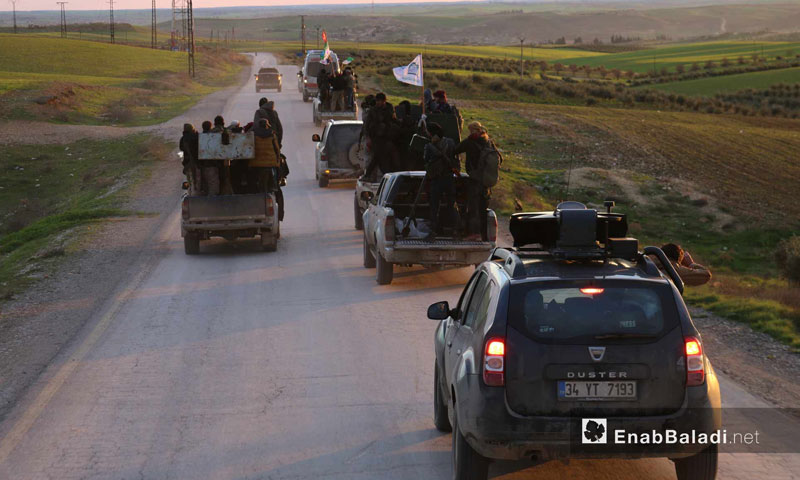The city of Manbij, eastern rural Aleppo, is anticipating what the few upcoming days, or hours, would reveal, for the Turkey-backed “National Army” factions have announced readiness to start the military operation in the area, in sync to the arrival of massive Turkish reinforcements, including tanks and canons and, most importantly, the end of the “decisive summit” between Turkey and Russia, which will have certain on ground impact, particularly in the areas from where the United States declared withdrawal.
The summit, which brought the Turkish Ministry of Foreign Affairs and his Russian counterpart together in Moscow, ended with an agreement on coordinating the action of both sides’ forces as to eliminate the “risk of terrorism in Syria,” providing that their tight cooperation continues concerning Syria and regional affairs.
Manbij is one of the targets aimed at by the anticipated Turkish military operation, along with the border cities of Tell Abyad, Ras al-Ayn, Ayn al-Arab(Kobanî).
Today, many questions are raised about Manbij’s destiny and its future and wither it would be a witness to a deal, according to which the Kurdish (People’s Protection Units) would retreat from it completely and without a military operation just to satisfy Turkey.
Turkey declared that it agreed with the U.S. as to continue with Manbij’s road map, prior to the latter’s complete withdrawal from Syria.
“We informed the Americans of the necessity that their withdrawal from Syria does not serve the agenda of the PYD and the PKK,” he added.
Afrin’s Scenario
Last week was thriving with Manbij-related developments, on top of which the Syrian regime’s declaration of entering the city after being called on by the “Units” in a statement, in which they said: “We call on the Syrian state, to which we belong as a land, people and borders to deploy its armed forces to handle their posts and protect Manbij from the Turkish threats.”
Assad’s forces entered Arima town only, located to the west of the city of Manbij, contrary to what the Ministry of Defense has reported in its statement.
Going back to 2017, the “Border Guard,” a regime-affiliated group, announced spread over the major confrontation lines with the areas controlled by the “Euphrates Shield” factions during the military operations against the “Islamic State” (ISIS).
The day following the declaration of Assad’s forces entry to the city, commanders of the “National Army” told Enab Baladi that Assad’s forces retreated from the posts in the Arima town towards the Taiha crossing, controlled by them.
On Friday, December 28, the US-led coalition refuted the changes said to have befell the control map in the city of Manbij, hours after Assad’s forces declaration.
The negation was preceded by a threat, directed by the Turkish Ministry of Defense at the Syrian regime as not to undertake any provocative actions in Manbij.
“We warn all the sides in Syria about the necessity of avoiding all provocative actions and discourse, which might inflate the situation,” the Turkish Ministry of Defense stated.
What Manbij is being a stage to today is similar to what happened in Afrin during the operation “Olive Branch,” for the Syrian regime deployed “unofficial” affiliated militias to the area’s fronts, saying that they will be combating the advance of the “National Army” and the Turkish army.
The remarkable thing about Afrin is that the Syrian regime did not officially comment on the entry of its forces, of whom 80 personnel were killed in a Turkish shelling, as pro-regime news networks reported in March 2018.
What Distinguishes Manbij?
Manbij is the largest city in Aleppo and the center to its eastern rural parts; it is also the second largest Syrian city, following al-Qamishli, which is not a center of a governorate.
About 40km separate it from Turkish-Syrian borders, while 80 km separate it from the city of Aleppo (north-east). Before 2011, it was populated by 100 thousand persons according to the statistics issued by Aleppo Provincial Council. The number fell short to about 30 thousand or 40 thousand persons in 2016.
Manbij is of an Arab majority, in addition to other minorities, Kurds, Circassians and Turkman. It occupies an important geographical location, for it is a joint connecting Turkey in the north, Raqqa in the east, Hama in the south and Aleppo in the west.
The city also possesses the largest grain silos in the northern area, which took three years of construction and have been destroyed during the military operations the city witnessed prior to 2016 against ISIS.
The Syrian regime withdrew from Manbij in mid-2012 to be entered by the opposition factions, which preserved control over it until 2014 when ISIS advanced towards it, making it a major post and a strip connecting this area with its areas of control in Raqqa and Deir ez-Zor.
The “Syrian Democratic Forces” (SDF) controlled Manbij in August 2016 with a direct support from the U.S. after “violence” battles that lasted for months against ISIS, in which it resorted to street wars and booby-trapping residential buildings.

